Modal and Structural Identification of Historic Bell Tower in Čuntić, Croatia Using Ambient Vibration Testing
Abstract
:1. Introduction
2. The Bell Tower of the Church of St. Anthony of Padua in Čuntić, Croatia
2.1. General Information
2.2. Damage Description
3. Ambient Vibration Testing
4. Operational Modal Analysis (OMA)
5. FE Modelling and Model Updating
6. Discussion
7. Conclusions
Author Contributions
Funding
Institutional Review Board Statement
Informed Consent Statement
Data Availability Statement
Conflicts of Interest
References
- Lourenco, P.B. Computations on historic masonry structures. Prog. Struct. Eng. Mater. 2002, 4, 301–319. [Google Scholar] [CrossRef]
- Betti, M.; Vignoli, A. Modelling and analysis of a Romanesque church under earthquake loading: Assessment of seismic resistance. Eng. Struct. 2008, 30, 352–367. [Google Scholar] [CrossRef]
- Bayraktar, A.; Şahin, A.; Özcan, D.M.; Yıldırım, F. Numerical damage assessment of Haghia Sophia bell tower by nonlinear FE modeling. Appl. Math. Model. 2010, 34, 92–121. [Google Scholar] [CrossRef]
- Foraboschi, P. Church of San Giuliano di Puglia: Seismic repair and upgrading. Eng. Fail. Anal. 2013, 33, 281–314. [Google Scholar] [CrossRef]
- Bartoli, G.; Betti, M.; Vignoli, A. A numerical study on seismic risk assessment of historic masonry towers: A case study in San Gimignano. Bull. Earthq. Eng. 2016, 14, 1475–1518. [Google Scholar] [CrossRef]
- Saisi, A.; Gentile, C. Post-earthquake diagnostic investigation of a historic masonry tower. J. Cult. Herit. 2015, 16, 602–609. [Google Scholar] [CrossRef]
- Saisi, A.; Gentile, C.; Ruccolo, A. Pre-diagnostic prompt investigation and static monitoring of a historic bell-tower. Constr. Build. Mater. 2016, 122, 833–844. [Google Scholar] [CrossRef]
- da Silva Gonçalves, L.M.; Rodrigues, H.; Gaspar, F. Nondestructive Techniques for the Assessment and Preservation of Historic Structures; CRC Press: Boca Raton, FL, USA, 2017. [Google Scholar]
- Pavlovic, M.; ·Trevisani, S.; Cecchi, A. A procedure for the structural identification of masonry towers. J. Nondestruct. Eval. 2019, 38, 38. [Google Scholar] [CrossRef]
- Saisi, A.; Gentile, C. Investigation Strategy for Structural Assessment of Historic Towers. Infrastructures 2020, 5, 106. [Google Scholar] [CrossRef]
- Bartoli, G.; Betti, M.; Galano, L.; Pieraccini, M. Seismic Assessment of Historic Masonry Towers: Non-invasive Techniques and Analysis Methodologies. In Handbook of Cultural Heritage Analysis; D’Amico, S., Venuti, V., Eds.; Springer: Cham, Switzerland, 2022; pp. 1221–1268. [Google Scholar]
- Rainieri, C.; Fabbrocino, G. Operational Modal Analysis of Civil Engineering Structures: An Introduction and Guide for Applications; Springer: New York, NY, USA; Heidelberg, Germany; Dordrecht, The Netherlands; London, UK, 2014; Volume 2. [Google Scholar]
- Radnić, J.; Grgić, N.; Buzov, A.; Banović, I.; Smilović Zulim, M.; Baloević, G.; Sunara, M. Mw 6.4 Petrinja earthquake in Croatia: Main earthquake parameters, impact on buildings and recommendation for their structural strengthening. Gradevinar 2021, 73, 1109–1128. [Google Scholar]
- Atalić, J.; Demšić, M.; Baniček, M.; Uroš, M.; Dasović, I.; Prevolnik, S.; Kadić, A.; Šavor Novak, M.; Nastev, M. The December 2020 Magnitude (Mw) 6.4 Petrinja Earthquake, Croatia: Seismological Aspects, Emergency Response and Impacts. Res. Sq. 2022, 21, 1–42. [Google Scholar] [CrossRef]
- Gentile, C.; Saisi, A. Ambient vibration testing of historic masonry towers for structural identification and damage assessment. Constr. Build. Mater. 2007, 21, 1311–1321. [Google Scholar] [CrossRef]
- Barsotti, R.; Bennati, S.; Nardini, L.; Salvatore, W. Characterisation of the mechanical behaviour of the bell tower of the cathedral of San Miniato (Pisa). WIT Trans. Built Environ. 2008, 98, 343–355. [Google Scholar]
- Bayraktar, A.; Türker, T.; Sevım, B.; Altunişik, A.C.; Yildirim, F. Modal parameter identification of Hagia Sophia bell-tower via ambient vibration test. J. Nondestruct. Eval. 2009, 28, 37–47. [Google Scholar] [CrossRef]
- Foti, D.; Diaferio, M.; Giannoccaro, N.I.; Mongelli, M. Ambient vibration testing, dynamic identification and model updating of a historic tower. NDT E Int. 2012, 47, 88–95. [Google Scholar] [CrossRef]
- Bartoli, G.; Betti, M.; Giordano, S. In situ static and dynamic investigations on the “Torre Grossa” masonry tower. Eng. Struct. 2013, 52, 718–733. [Google Scholar] [CrossRef]
- Ranieri, C. On the Estimation of the Fundamental Modal Properties of Italian Historical Masonry Towers. 2014. Available online: https://iris.unimol.it/handle/11695/48344 (accessed on 28 February 2023).
- Gentile, C.; Saisi, A.; Cabboi, A. Structural identification of a masonry tower based on operational modal analysis. Int. J. Archit. Herit. 2015, 9, 98–110. [Google Scholar] [CrossRef]
- Ferraioli, M.; Miccoli, L.; Abruzzese, D.; Mandara, A. Dynamic characterisation and seismic assessment of medieval masonry towers. Nat. Hazards 2017, 86, 489–515. [Google Scholar] [CrossRef]
- Diaferio, M.; Foti, D.; Potenza, F. Prediction of the fundamental frequencies and modal shapes of historic masonry towers by empirical equations based on experimental data. Eng. Struct. 2018, 156, 433–442. [Google Scholar] [CrossRef]
- Standoli, G.; Giordano, E.; Milani, G.; Clementi, F. Model Updating of Historical Belfries Based on Oma Identification Techniques. Int. J. Arch. Herit. 2020, 15, 132–156. [Google Scholar] [CrossRef]
- Torelli, G.; D’Ayala, D.; Betti, M.; Bartoli, G. Analytical and numerical seismic assessment of heritage masonry towers. Bull. Earthq. Eng. 2020, 18, 969–1008. [Google Scholar] [CrossRef]
- Capanna, I.; Cirella, R.; Aloisio, A.; Alaggio, R.; Di Fabio, F.; Fragiacomo, M. Operational Modal Analysis, Model Update and Fragility Curves Estimation, through Truncated Incremental Dynamic Analysis, of a Masonry Belfry. Buildings 2021, 11, 120. [Google Scholar] [CrossRef]
- Kita, A.; Cavalagli, N.; Venanzi, I.; Ubertini, F. A new method for earthquake-induced damage identification in historic masonry towers combining OMA and IDA. Bull. Earthq. Eng. 2021, 19, 5307–5337. [Google Scholar] [CrossRef]
- Milani, G.; Clementi, F. Advanced Seismic Assessment of Four Masonry Bell Towers in Italy after Operational Modal Analysis (OMA) Identification. Int. J. Archit. Herit. 2021, 15, 157–186. [Google Scholar] [CrossRef]
- Trešnjo, F.; Humo, M.; Casarin, F.; Ademović, N. Experimental Investigations and Seismic Assessment of a Historical Stone Minaret in Mostar. Buildings 2023, 13, 536. [Google Scholar] [CrossRef]
- Lariviere, O.; Chadefaux, D.; Sauret, C.; Kordulas, L.; Thoreux, P. Modal Characterization of Manual Wheelchairs. Vibration 2022, 5, 442–463. [Google Scholar] [CrossRef]
- Azim, M.R.; Gül, M. Development of a Novel Damage Detection Framework for Truss Railway Bridges Using Operational Acceleration and Strain Response. Vibration 2021, 4, 422–443. [Google Scholar] [CrossRef]
- Castro, G.; Zurita, G. Applications of Operational Modal Analysis in Gearbox and Induction Motor, Based on Random Decrement Technique and Enhanced Ibrahim Time Method. Appl. Sci. 2022, 12, 5284. [Google Scholar] [CrossRef]
- Wang, C.; Huang, H.; Lai, X.; Chen, J. A new online operational modal analysis method for vibration control for linear time-varying structure. Appl. Sci. 2020, 10, 48. [Google Scholar] [CrossRef]
- Fu, W.; Wang, C.; Chen, J. Operational modal analysis for vibration control following moving window locality preserving projections for linear slow-time-varying structures. Appl. Sci. 2021, 11, 791. [Google Scholar] [CrossRef]
- Official Site of the Diocese of Sisak. Available online: https://biskupija-sisak.hr/biskupija-2/krizni-put-sisacke-crkve/ (accessed on 13 February 2023).
- Official Site of HBM. Available online: https://www.hbm.com/en/ (accessed on 17 February 2023).
- Cantieni, R. Experimental methods used in system identification of civil engineering structures. In Proceedings of the 1st International Operational Modal Analysis Conference (IOMAC-2005), Aalborg, Denmark, 26–27 April 2005. [Google Scholar]
- Structural Vibration Solutions ApS. ARTeMIS Modal Pro Software, version 7.0; NOVI Science Park: Aalborg, Denmark, 2021.
- Hasan, M.D.A.; Ahmad, Z.A.B.; Salman Leong, M.; Hee, L.M. Enhanced frequency domain decomposition algorithm: A review of a recent development for unbiased damping ratio estimates. J. Vibroeng. 2018, 20, 1919–1936. [Google Scholar] [CrossRef]
- Van Overschee, P.; De Moor, B.L.; Hensher, D.A.; Rose, J.M.; Greene, W.H.; Train, K.; Greene, W.; Krause, E.; Gere, J.; Hibbeler, R. Subspace Identification for the Linear Systems: Theory–Implementation-Application; Katholieke Universiteit Leuven: Leuven, Belgium; Kluwer Academic Publishers: Boston, MA, USA, 1996. [Google Scholar]
- Cismasiu, C.; Narciso, A.C.; Amarante dos Santos, F.P. Experimental dynamic characterization and finite-element updating of a footbridge structure. J. Perform. Constr. Facil. 2014, 29, 4014116. [Google Scholar] [CrossRef]
- Shokravi, H.; Shokravi, H.; Bakhary, N.; Rahimian Koloor, S.S.; Petrů, M. A Comparative Study of the Data-Driven Stochastic Subspace Methods for Health Monitoring of Structures: A Bridge Case Study. Appl. Sci. 2020, 10, 3132. [Google Scholar] [CrossRef]
- Brincker, R.; Zhang, L.; Andersen, P. Modal identification from ambient responses using frequency domain decomposition. In Proceedings of the 18th International Modal Analysis Conference (IMAC), San Antonio, TX, USA, 7–10 February 2000; pp. 625–630. [Google Scholar]
- Official Site of the SCIA Engineer. Available online: https://www.scia.net/en/scia-engineer (accessed on 13 February 2023).
- Dongarra, J.; Sullivan, F. Guest editors’ introduction to the top 10 algorithms. Comput. Sci. Eng. 2000, 2, 22–23. [Google Scholar] [CrossRef]
- Bathe, K.J. Solution Methods for Large Generalized Eigenvalue Problems in Structural Engineering; Report UCSESM 71-20; Department of Civil Engineering, University of California, Berkeley: Berkeley, CA, USA, 1971. [Google Scholar]
- Bathe, K.J. The subspace iteration method—Revisited. Comput. Struct. 2013, 126, 177–183. [Google Scholar] [CrossRef]


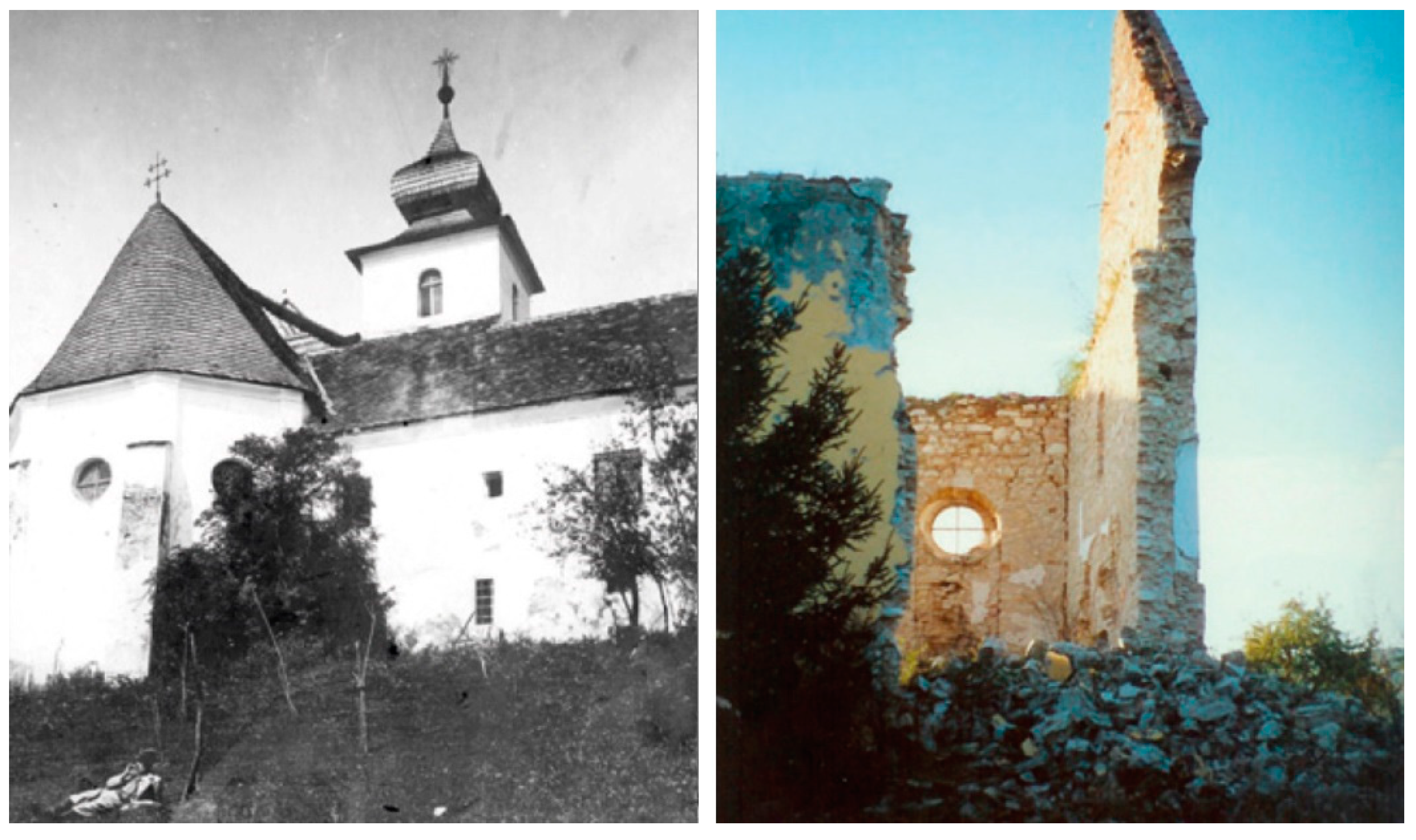

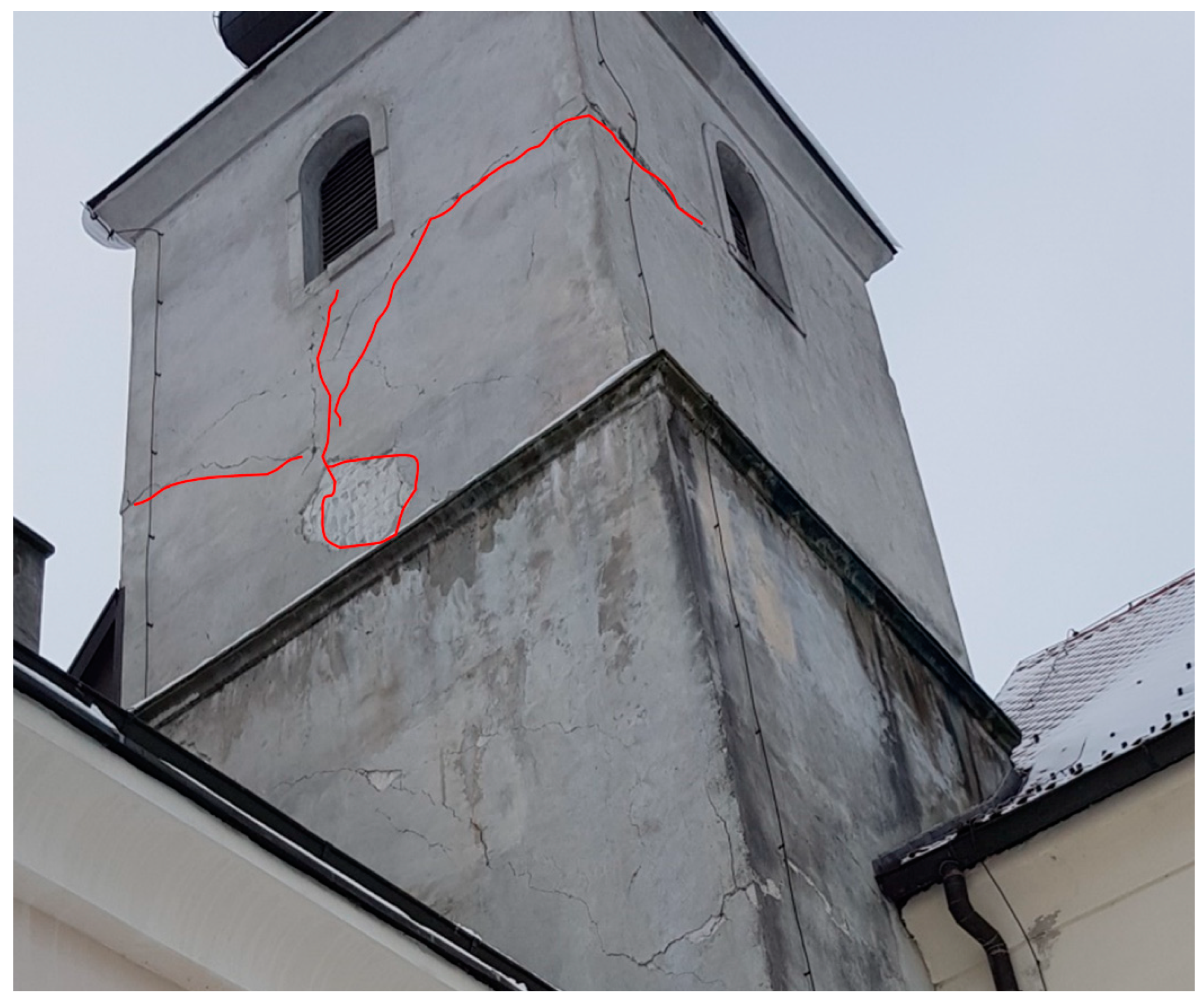

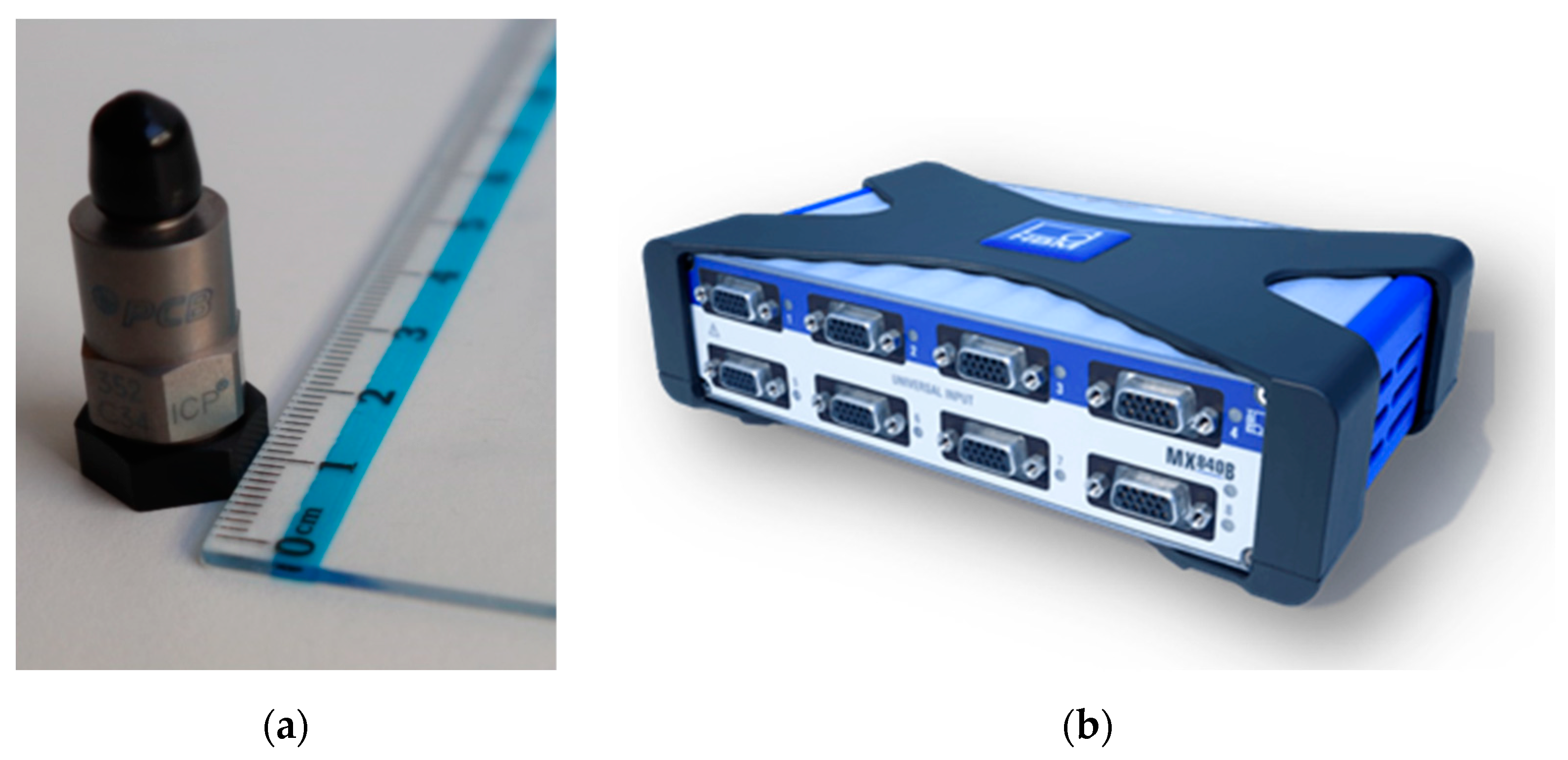
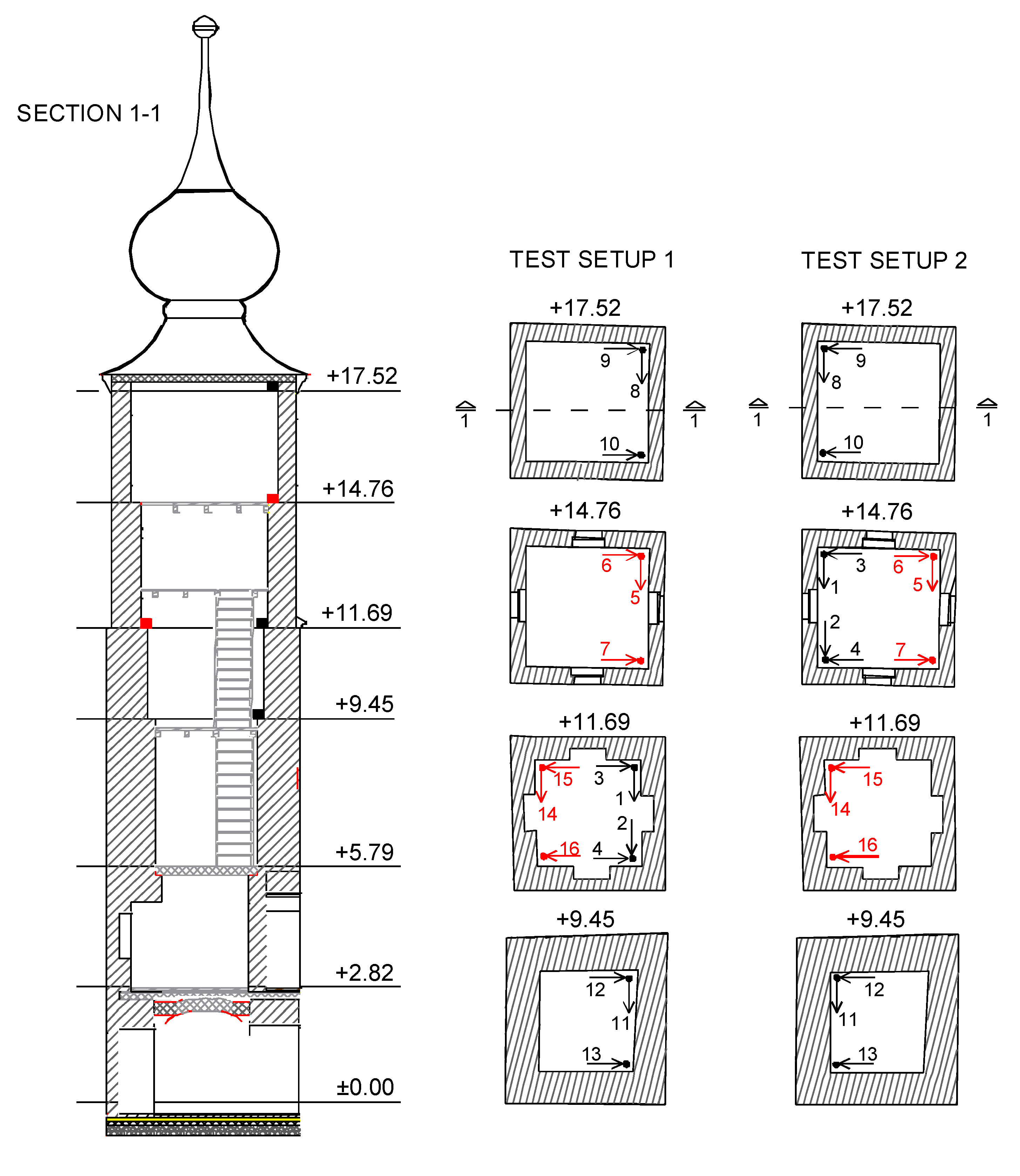

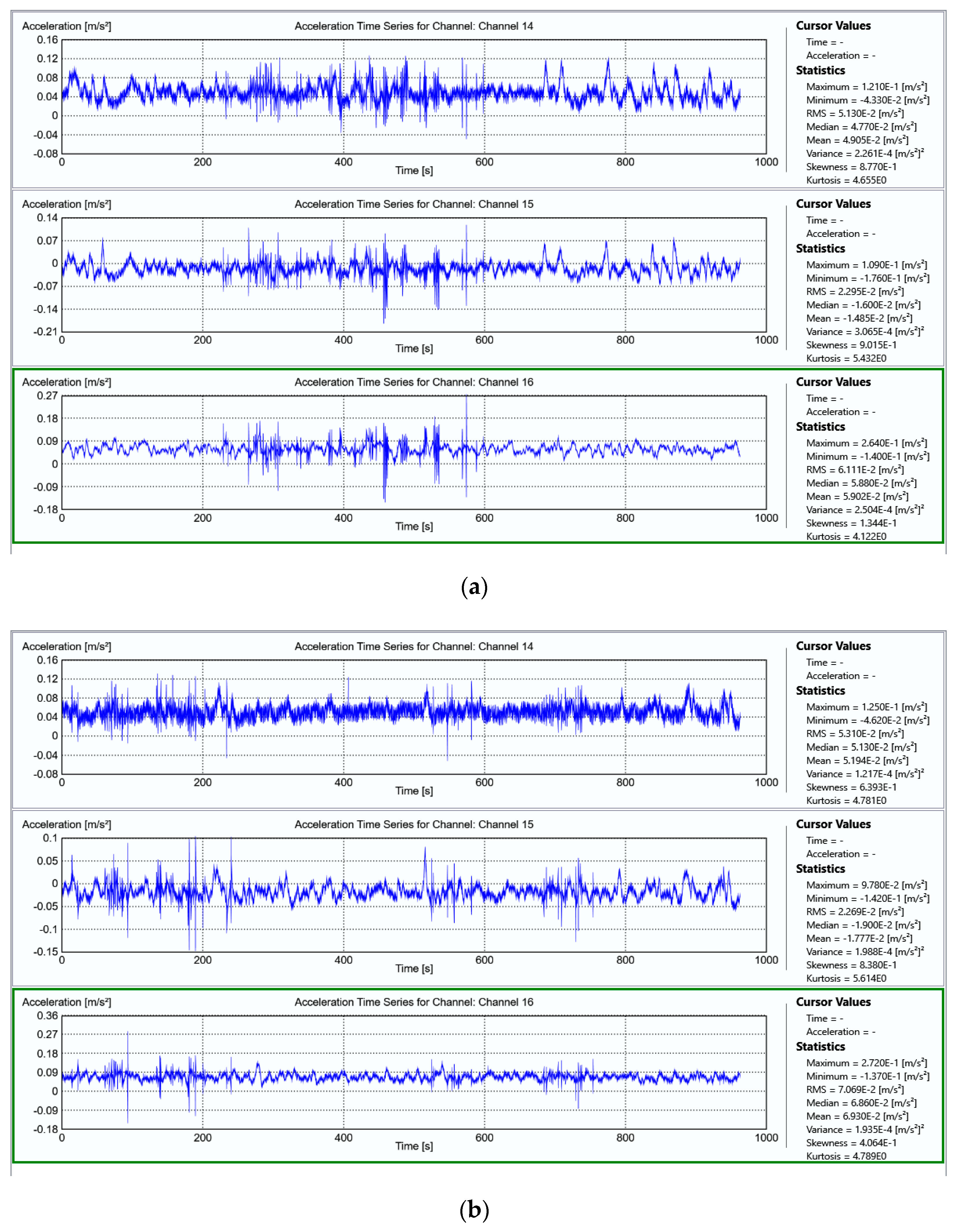

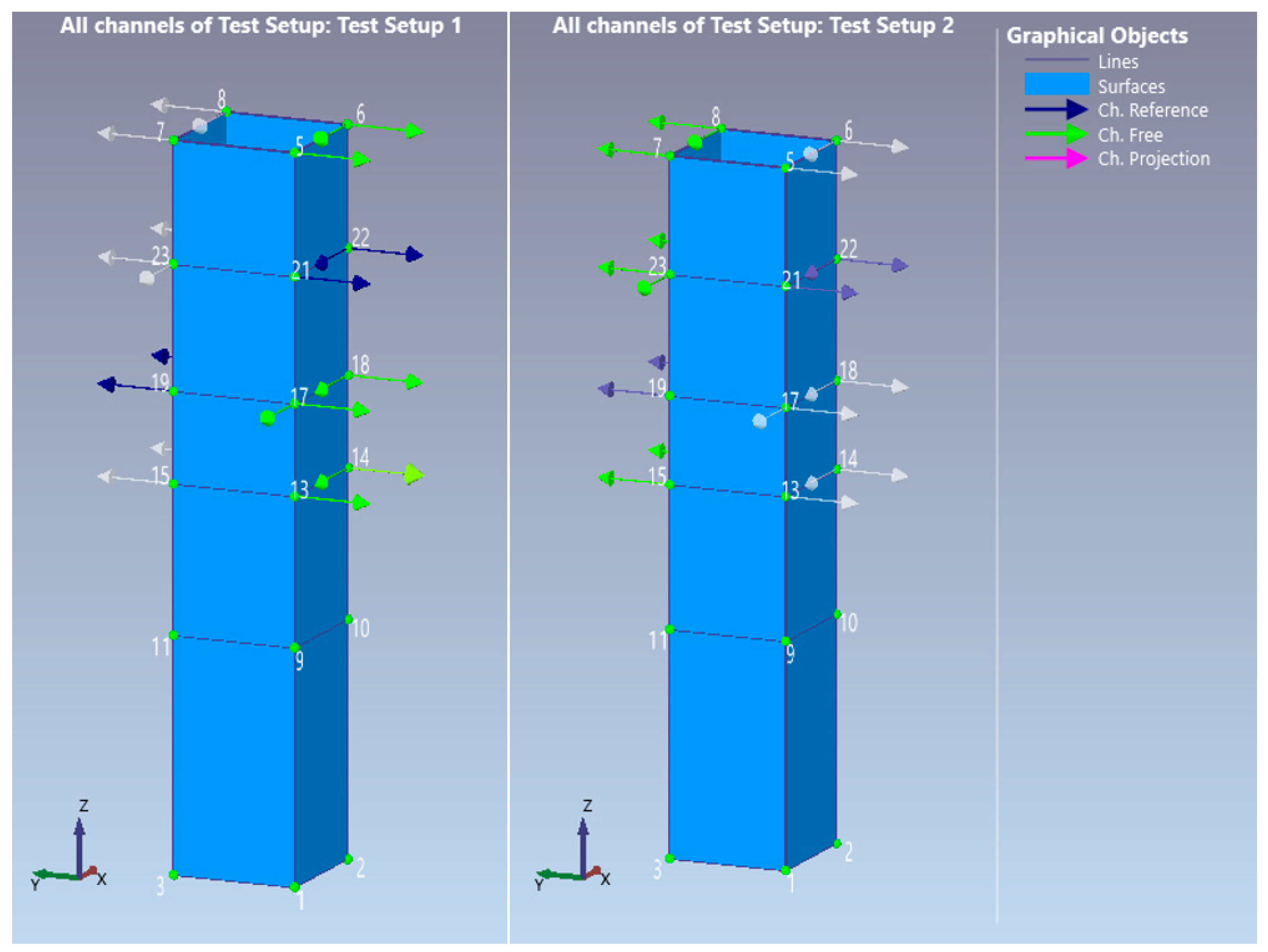
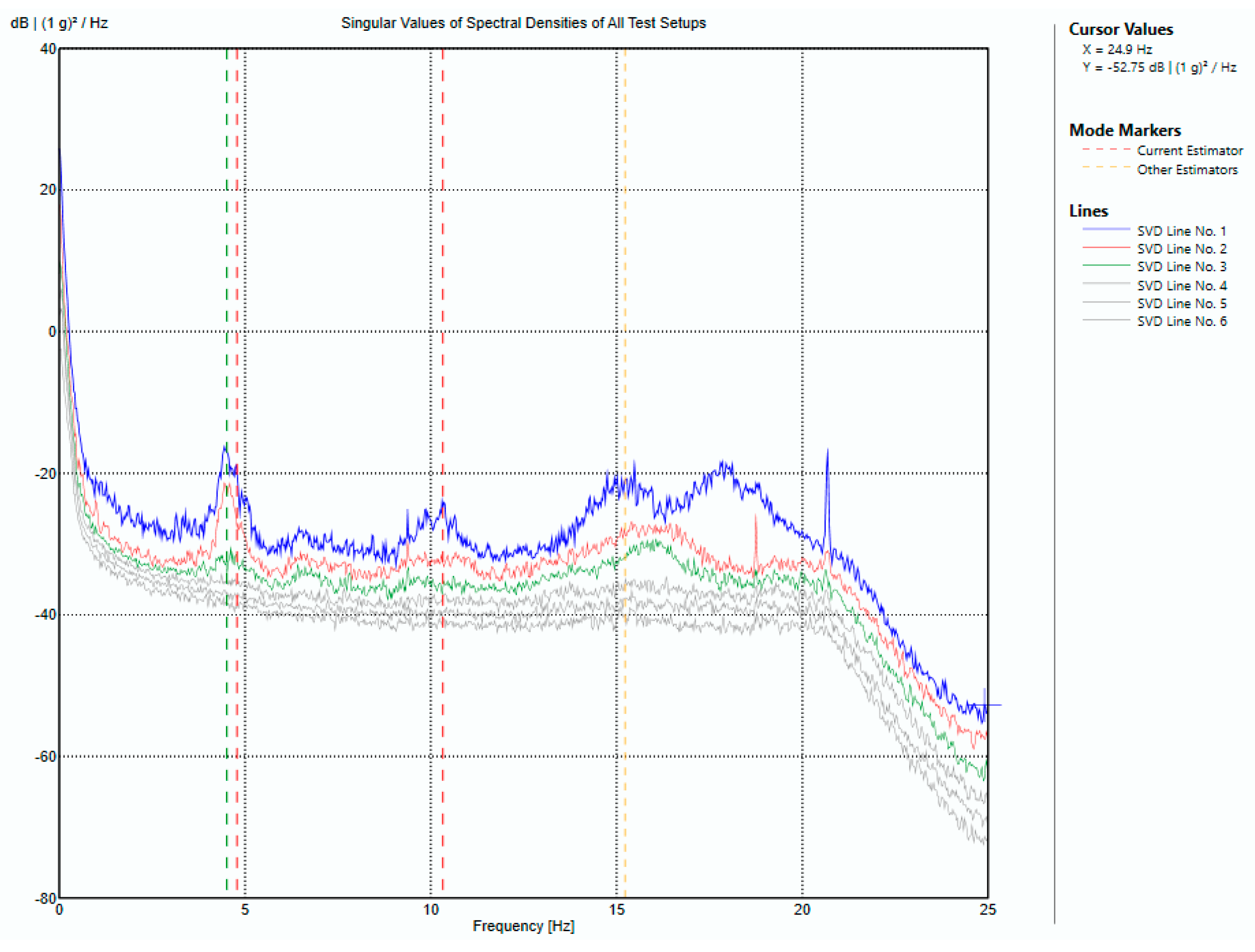
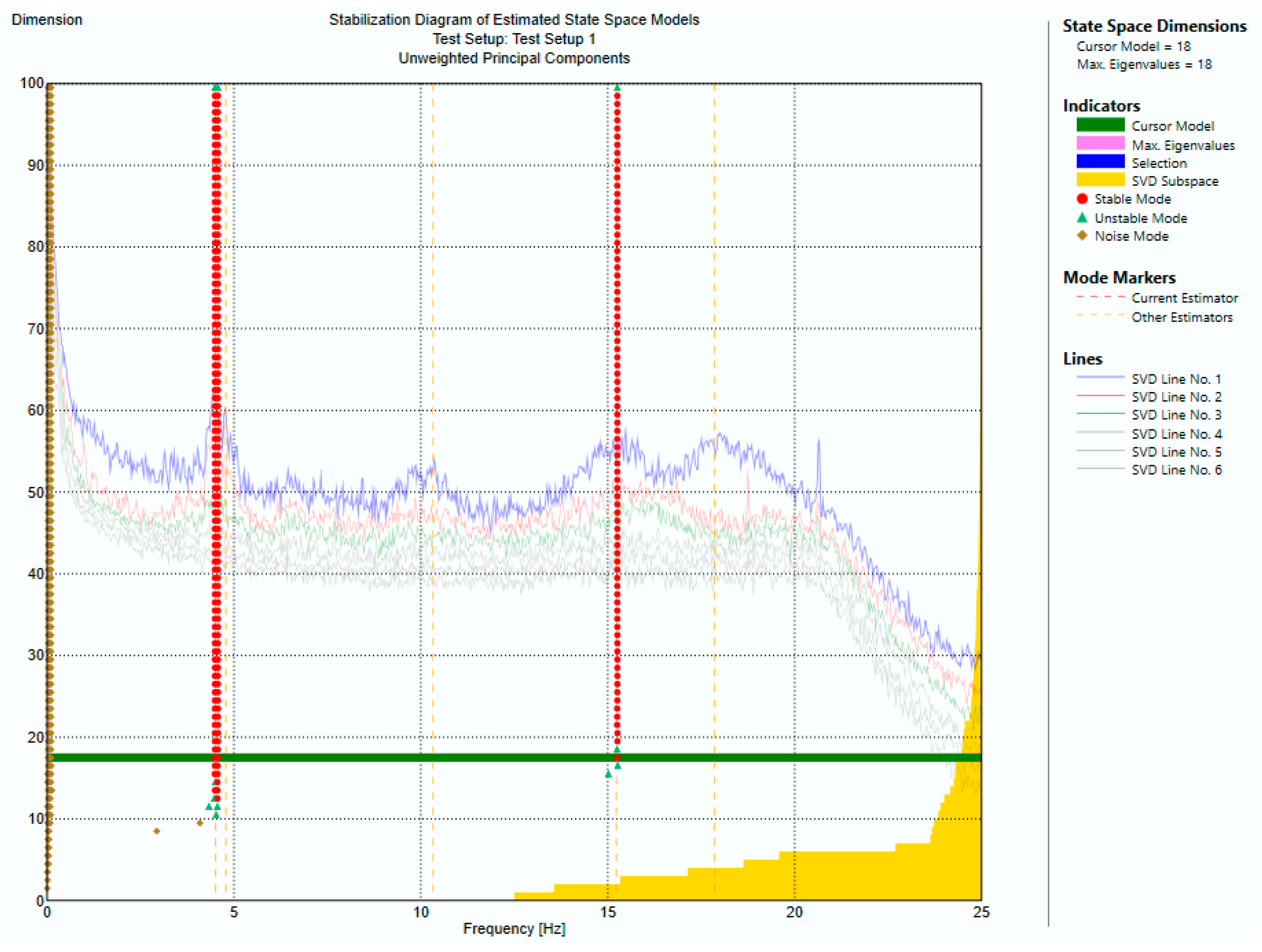
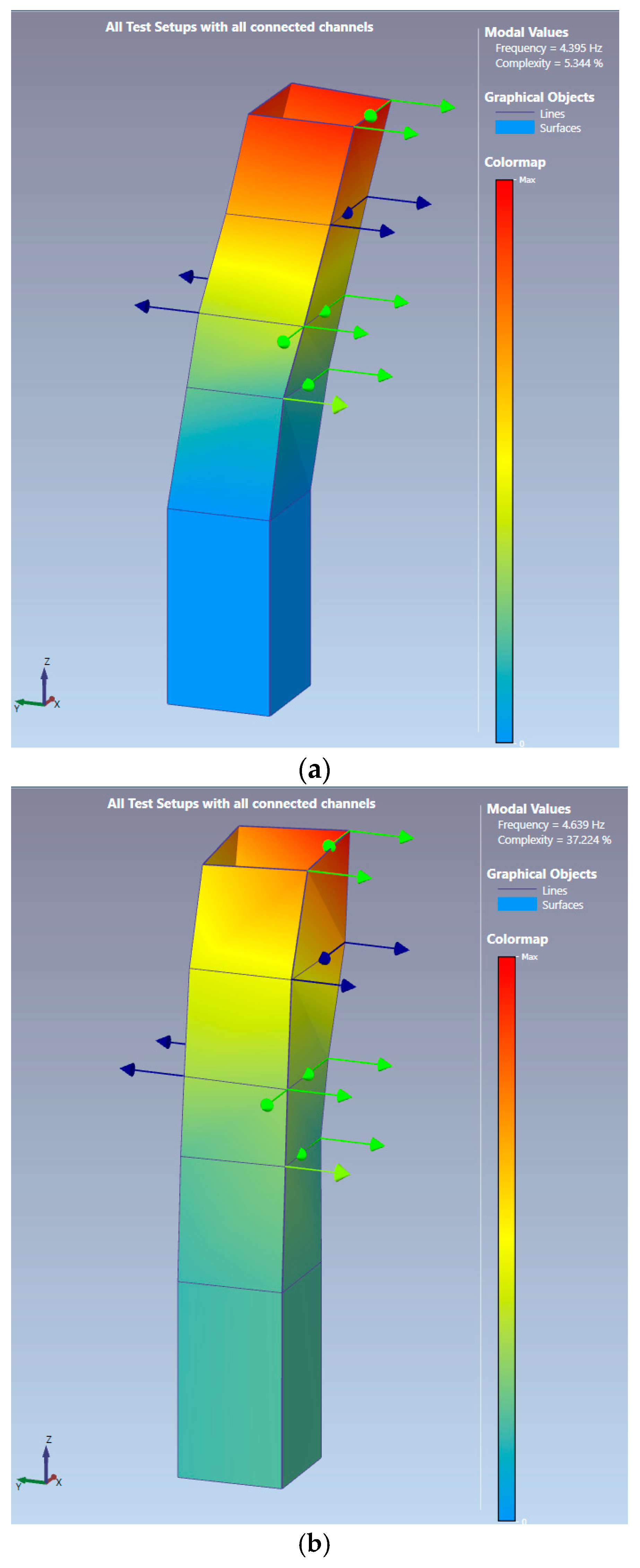

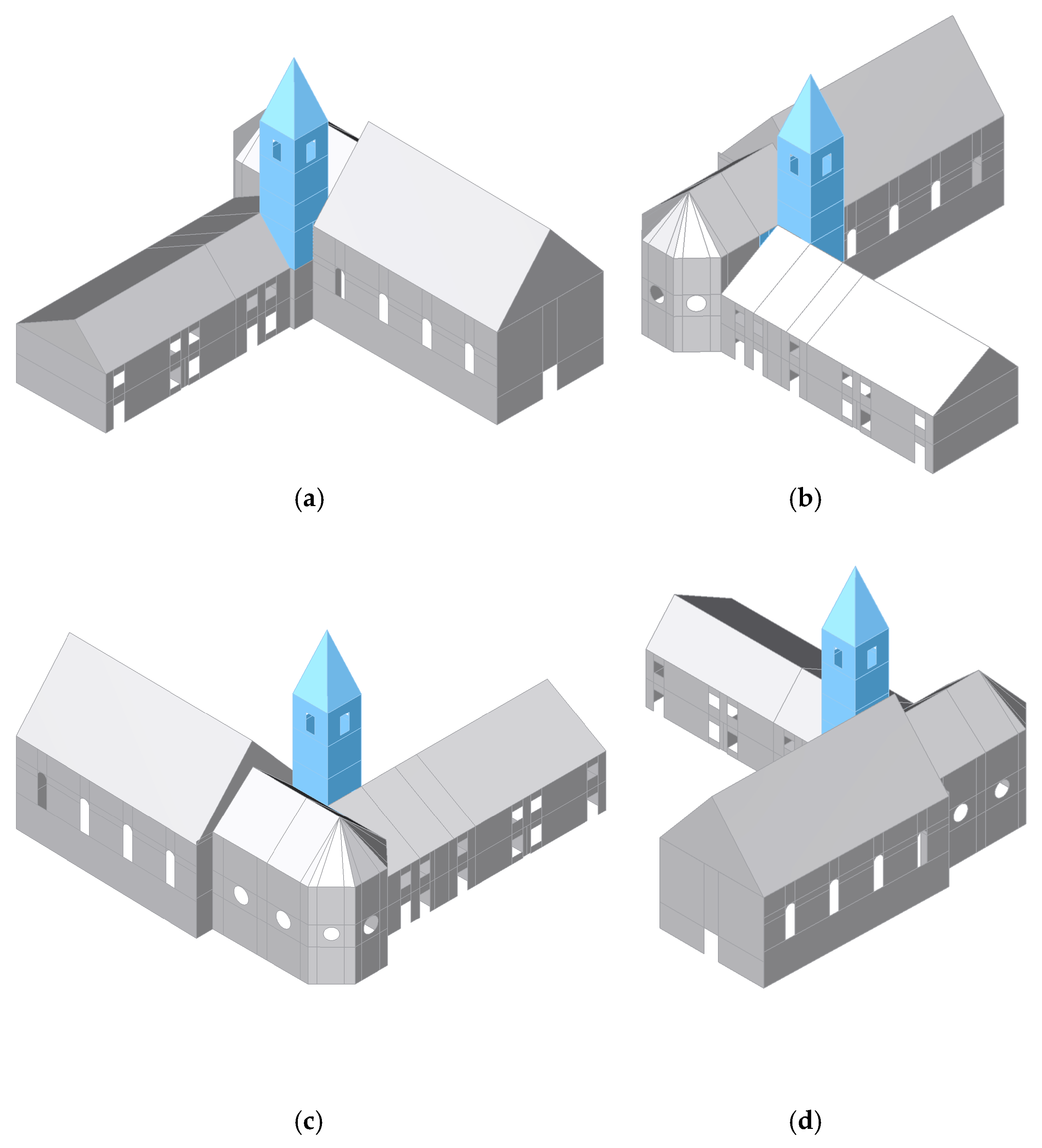

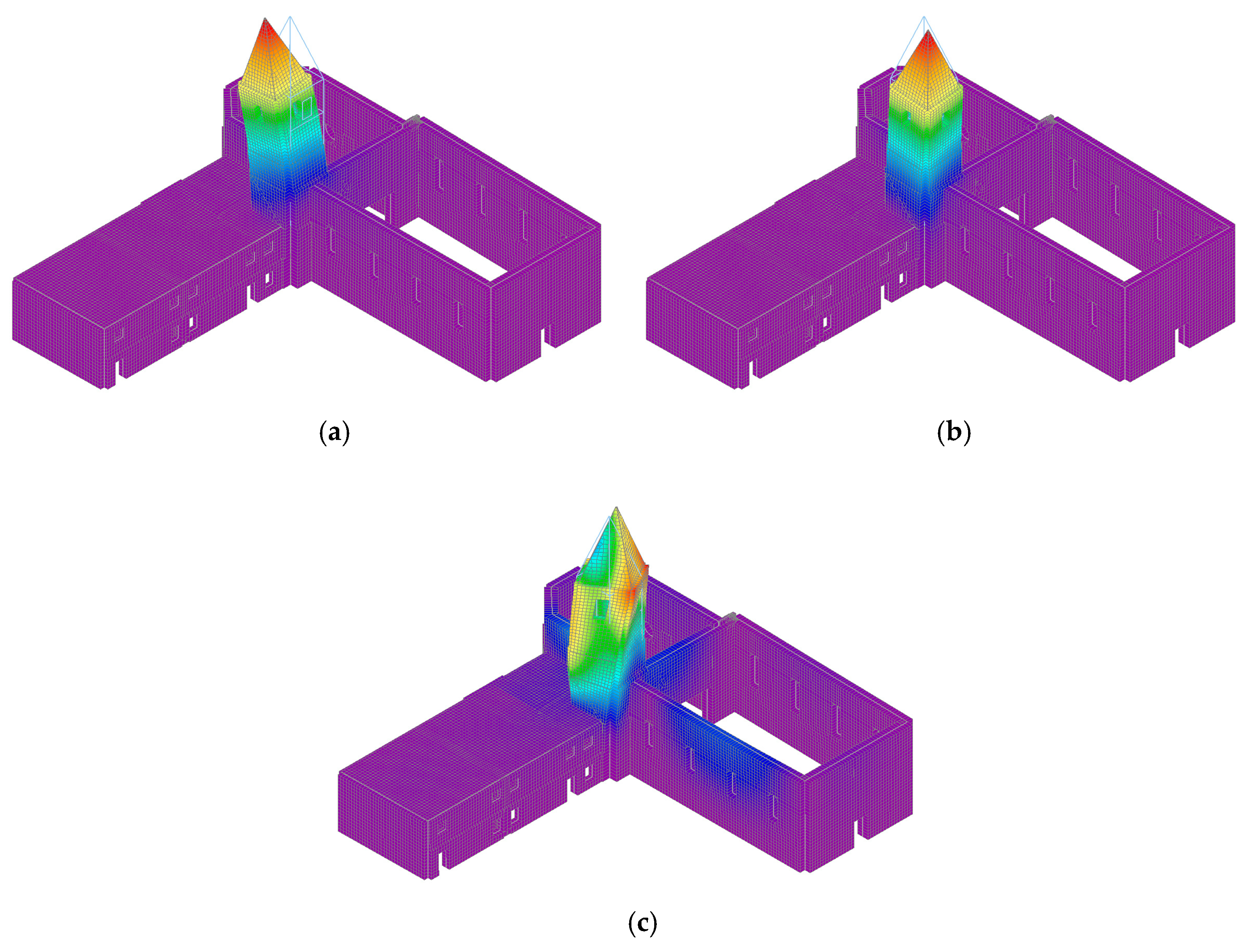
| Mode | Frequency [Hz] | Damping [%] | Complexity [%] |
|---|---|---|---|
| 1 | 4.395 | 0.024 | 5.344 |
| 2 | 4.639 | 0.032 | 3.722 |
| 3 | 10.303 | 1.174 | 11.538 |
| Material | Young’s Modulus E [MPa] | Poisson Coefficient ν | Bulk Density φ [kN/m3] |
|---|---|---|---|
| Concrete | 30,000 | 0.20 | 24.5 |
| Wood | 7000 | 0.15 | 4.0 |
| Masonry | 6000 | 0.30 | 18.0 |
| Mode | Frequency EXP fEXP [Hz] | Frequency NM fNM [Hz] | Period NM T [s] | Wx,i/Wx,Tot [%] | Wy,i/Wy,Tot [%] | Wz,i/Wz,Tot [%] |
|---|---|---|---|---|---|---|
| 1 | 4.395 | 7.04 | 0.14 | 0.0003 | 0.2027 | 0 |
| 2 | 4.639 | 7.77 | 0.13 | 0.09 | 0 | 0 |
| 3 | 10.303 | 17.10 | 0.06 | 0.009 | 0.15 | 0 |
| Material | Young’s Modulus E [MPa] | Poisson Coefficient ν | Bulk Density φ [kN/m3] |
|---|---|---|---|
| Concrete | 30,000 | 0.20 | 24.5 |
| Wood | 7000 | 0.15 | 4.0 |
| Masonry–church and monastery | 6000 | 0.30 | 18.0 |
| Masonry–bell tower lower level (<11.69) | 2000 | 0.30 | 17.0 |
| Masonry–bell tower higher level (>11.69) | 1300 | 0.30 | 15.5 |
| Mode | Frequency EXP fEXP [Hz] | Frequency NM fNM [Hz] | Δf [%] | Wx,i/Wx,Tot [%] | Wy,i/Wy,Tot [%] | Wz,i/Wz,Tot [%] |
|---|---|---|---|---|---|---|
| 1 | 4.395 | 4.55 | 3.53 | 0.01 | 0.18 | 0 |
| 2 | 4.639 | 4.75 | 2.39 | 0.07 | 0 | 0 |
| 3 | 10.303 | 11.22 | 8.90 | 0.01 | 0.14 | 0 |
Disclaimer/Publisher’s Note: The statements, opinions and data contained in all publications are solely those of the individual author(s) and contributor(s) and not of MDPI and/or the editor(s). MDPI and/or the editor(s) disclaim responsibility for any injury to people or property resulting from any ideas, methods, instructions or products referred to in the content. |
© 2023 by the authors. Licensee MDPI, Basel, Switzerland. This article is an open access article distributed under the terms and conditions of the Creative Commons Attribution (CC BY) license (https://creativecommons.org/licenses/by/4.0/).
Share and Cite
Sunara, M.; Banović, I.; Buzov, A.; Grgić, N. Modal and Structural Identification of Historic Bell Tower in Čuntić, Croatia Using Ambient Vibration Testing. Appl. Sci. 2023, 13, 11494. https://doi.org/10.3390/app132011494
Sunara M, Banović I, Buzov A, Grgić N. Modal and Structural Identification of Historic Bell Tower in Čuntić, Croatia Using Ambient Vibration Testing. Applied Sciences. 2023; 13(20):11494. https://doi.org/10.3390/app132011494
Chicago/Turabian StyleSunara, Marina, Ivan Banović, Ante Buzov, and Nikola Grgić. 2023. "Modal and Structural Identification of Historic Bell Tower in Čuntić, Croatia Using Ambient Vibration Testing" Applied Sciences 13, no. 20: 11494. https://doi.org/10.3390/app132011494








